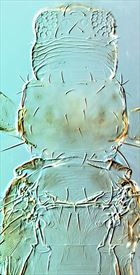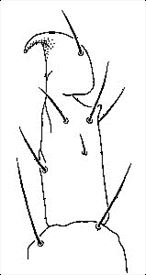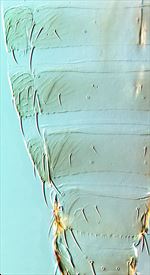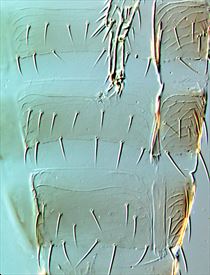Distinguishing features
Both sexes fully winged. Female variably bicoloured, with brown abdomen but pale head and thorax, or brownish yellow with posterior segments darker; sometimes with the body uniformly dark brown; legs pale; antennae brown, segment I and pedicel of III yellow; fore wing weakly and uniformly shaded; major setae brown. Head with cheeks rounded; vertex with a few lines of sculpture; setae relatively long. Antennae 7-segmented. Pronotum unsculptured, with 3 pairs of posteromarginal setae. Metanotum weakly reticulate. Pretarsus of foreleg with a small terminal claw. Fore wing with both setal rows complete, but setae usually separated by more than their length. Tergite VIII with a sparse, irregular comb similar to that in obscuratus. Pleurotergites with 2 or 3 discal setae. Sternites with 5–7 discal setae; sternite II with 3 pairs of posteromarginal setae.
Male similar to female; tergite IX similar to that of obscuratus; sternites V–VII each with a small (5 microns) circular pore plate.
Related species
There are 13 species of the genus Thrips recorded from New Zealand, of which five comprise an endemic group, out of a total of 280 species worldwide (Mound & Masumoto, 2005). All members of Thrips genus have paired ctenidia on the tergites, and on tergite VIII these are postero-mesad to the spiracles, and these species also lack ocellar setae pair I in front of the first ocellus. In contrast, Frankliniella species have ctenidia on tergite VIII antero-lateral to the spiracles, and a pair of setae is always present in front of the first ocellus. T. coprosmae is one of the five endemic members of this genus that share the presence of three pairs of posteromarginal setae on sternite II, and is very similar to T. obscuratus in chaetotaxy. However, the fore wing and metanotum are different, and the pretarsal claw on the fore legs is not found in any other member of this genus in New Zealand, although a similar structure occurs in Thrips calcaratus in Europe. Variation in body colour also occurs in T. obscuratus, and the sculpture of the mesonotum and metanotum is similar to that of T. austellus in being weakly raised into minute flanges.
Biological data
Associated with the young terminal leaves of Coprosma robusta, but also known from C. rotundifolia and C. pseudocuneata.
Distribution data
Endemic to New Zealand where it has been collected widely (AK, CL, BP, TO, WN / NN, SD, MB, BR, OL, CO, FD).
Family name
THRIPIDAE, THRIPINAE
Species name
Thrips coprosmae Mound
Original name and synonyms
Thrips coprosmae Mound, 1978: 618.
References
Mound LA (1978) Five new species of Thripidae (Thysanoptera) endemic to New Zealand. New Zealand Journal of Zoology 5: 615–622.
Mound LA & Masumoto M (2005) The genus Thrips (Thysanoptera, Thripidae) in Australia, New Caledonia and New Zealand. Zootaxa 1020: 1–64.
Martin NA & Mound LA (2004) Host plants for some New Zealand thrips (Thysanoptera: Terebrantia). New Zealand Entomologist 27: 119–123
Mound LA & Walker AK (1982) Terebrantia (Insecta: Thysanoptera). Fauna of New Zealand 1: 1–113.



